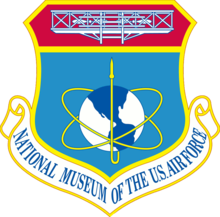NMUSAF
 |
|
| Established | 1923 |
|---|---|
| Location |
Wright-Patterson Air Force Base, Dayton, Ohio |
| Coordinates | 39°46′55″N 84°06′32″W / 39.781976°N 84.108892°W |
| Type | Military Aviation Museum |
| Visitors | 1,000,000+ |
| Director | Lt Gen John L. Hudson, USAF (Retired) |
| Curator | Krista Strider, Deputy Director/Senior Curator |
| Public transit access | Greater Dayton RTA Route 11 |
| Website | www |
The National Museum of the United States Air Force (formerly the United States Air Force Museum) is the official museum of the United States Air Force located at Wright-Patterson Air Force Base, 6 miles (9.7 km) northeast of Dayton, Ohio. The NMUSAF has one of the world's largest collections with more than 360 aircraft and missiles on display. The museum draws more than 1 million visitors each year, making it one of the most frequently visited tourist attractions in Ohio.
The museum dates to 1923, when the Engineering Division at Dayton's McCook Field first collected technical artifacts for preservation. In 1927, it moved to then-Wright Field in a laboratory building. In 1932, the collection was named the Army Aeronautical Museum and placed in a WPA building from 1935 until World War II. In 1948, the collection remained private as the Air Force Technical Museum. In 1954, the Air Force Museum became public and was housed in its first permanent facility, Building 89 of the former Patterson Field in Fairborn, which had been an engine overhaul hangar. Many of its aircraft were parked outside and exposed to the weather. It remained there until 1971, when the current facility opened. Not including its annex on Wright Field proper, the museum has more than tripled in square footage since 1971, with the addition of a second hangar in 1988, a third in 2003, and a fourth in 2016.
The museum announced a new name for the facility in October 2004. The former name, United States Air Force Museum, changed to National Museum of the United States Air Force.
The museum is a central component of the National Aviation Heritage Area.
The museum's collection contains many rare aircraft of historical or technological importance, and various memorabilia and artifacts from the history and development of aviation. Among them is one of four surviving Convair B-36 Peacemakers, the only surviving North American XB-70 Valkyrie and Bockscar—the Boeing B-29 Superfortress that dropped the Fat Man atomic bomb on Nagasaki during the last days of World War II.
...
Wikipedia
